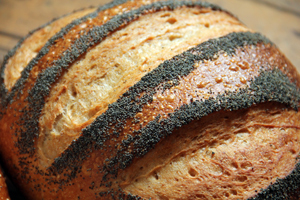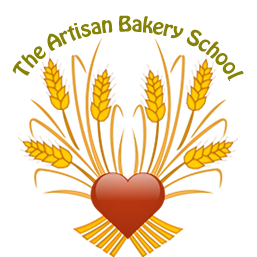Since we first started baking, we have learned a lot about our daily bread. We had no idea how many virtually unpronounceable enzymes, for example, can be involved in the average sliced white. Neither did we know that when you buy a bag of bread flour from a supermarket, expecting it to contain just flour, the law insists on four other ingredients being added but not listed: thiamin, nicotinic acid, iron and calcium carbonate, or common chalk. Only organic wholemeal flour is permitted to be sold without these, because its nutritional value is high enough in its natural state. The fact is that it is simply more profitable for industrial millers to strip out the goodness from the grain and sell it separately (wheatgerm, for example), before adding artificial ‘value’ to their standard, depleted flour.
 The four ingredients in our breads are: organic flour, water, salt and wild yeast culture. In certain cases we add a speck of baker’s yeast. We specialise in heirloom varieties of flour, notably the einkorn, spelt and khorasan from Doves Farm, and some flours from Gilchester Organics. We also add a lot of time and care. In fact, the shortest rising time for one of our loaves is at least five hours.
The four ingredients in our breads are: organic flour, water, salt and wild yeast culture. In certain cases we add a speck of baker’s yeast. We specialise in heirloom varieties of flour, notably the einkorn, spelt and khorasan from Doves Farm, and some flours from Gilchester Organics. We also add a lot of time and care. In fact, the shortest rising time for one of our loaves is at least five hours.
The umpteen ingredients in a typical, plastic-wrapped loaf from a factory, in addition to flour, salt, water and yeast, include some or all of the following: “Improvers” such as E481 (sodium stearoyl-2-lactylate),E472e (mono- and diacetyl tartaric acid esters of mono- and diglycerides of fatty acids)E920 (l-cysteine)E282 (calcium propionate),E220 (potassium sorbate), E300 (ascorbic acid), E260 (acetic acid), soya flour, vegetable fat and dextrose. More alarmingly, they may also include ‘processing agents’ (what happened to just baking?) such as fungal alpha amylase, transglutaminase, xylanase, maltogenic amylase, hemicellulase, oxidase, peptidase and protease. The law does not require these little extras to be listed in the ingredients. Oh, and the typical rising time for your factory sliced white is around 15 SECONDS.
To find out more about the contents of factory-produced bread – and the joys of real bread – visit www.realbreadcampaign.org and check out the Labelling page, or read Andrew Whitley’s Bread Matters.

